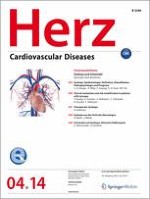Erschienen in:

01.06.2014 | Schwerpunkt
Therapie der Synkope
verfasst von:
Prof. Dr. D. Andresen
Erschienen in:
Herz
|
Ausgabe 4/2014
Einloggen, um Zugang zu erhalten
Zusammenfassung
Die therapeutischen Maßnahmen bei Synkopen orientieren sich an deren pathophysiologischen Entstehungsmechanismen. Bei der Reflexsynkope steht die Aufklärung des Patienten über das Erkennen prämonitorischer Warnsymptome ebenso in Vordergrund wie das Vermeiden von auslösenden Faktoren. Eine Betablockermedikation gilt heute als obsolet. Die Schrittmachertherapie ist nur bei eindeutiger Dokumentation spontaner Asystolien zum Zeitpunkt der Synkopen (EKG-Symptom-Korrelation) gerechtfertigt. Bei Patienten mit orthostatischer Hypotension sind Allgemeinmaßnahmen wie ausreichende Flüssigkeitszufuhr, aber auch Maßnahmen zur Verhinderung eines verzögerten venösen Rückflusses (z. B. elastische Strümpfe) erfolgreich. Vor allem bei älteren Patienten mit arterieller Hypertonie kann eine Veränderung der Blutdruckmedikation entscheidend für den therapeutischen Erfolg sein. Die Therapie bradykarder und tachykarder Rhythmusstörungen als Ursache für Synkopen besteht in einer Schrittmacher- bzw. ICD-Implantation. So einfach und wirkungsvoll diese Maßnahmen sind, so schwierig ist es im Einzelfall, den „klinischen Beleg“ dafür zu geben, dass eine Rhythmusstörung tatsächlich die Ursache für die Synkopen ist. Die Möglichkeit mit neuen miniaturisierten injizierbaren EKG-Rekordern eine solche Kausalität herbeizuführen, ist für die therapeutische Entscheidungsfindung im klinischen Alltag von unschätzbarem Wert. Die Grenze dieser Vorgehensweise wird allerdings gerade beim Verdacht auf lebensbedrohliche Rhythmusstörungen offensichtlich, denn der einzige Unterschied zwischen einer Synkope und dem plötzlich Herztod ist, dass man in dem einen Fall wieder aufwacht.